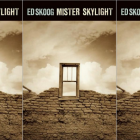Staying With the Tension
Guest post by Megan Mayhew Bergman
When we were in elementary school, my sister and I would always cut our viewing of The Sound of Music short because:
A) it was a seriously long movie, and
B) I couldn’t stand to watch Rolf crouch down in his jodhpurs and point his gun at the Von Trapps. It broke my heart and made me nervous.
(We’d also fast forward past the part where Julie Andrews sang about her “wicked childhood” and kissed Captain Von Trapp. Ew. We much preferred her puppet shows, making clothes from drapes, and singing on staircases with cherub-cheeked Marta.)
Even now, when my husband and I sit down to view a National Geographic or Discovery Channel wildlife program, I can’t watch when I know the lion is about to maul the gazelle, or the baby elephant is not going to make it through the dry season. I can’t watch the young wildebeest approach the dim waters where underneath a crocodile waits. At the movies, I cover my eyes during shoot-em-up scenes. When tension skyrockets on screen, I make up excuses about needing something in the kitchen, placing a phone call, or turning in early.
I have a problem staying with the tension.
And that is a serious problem if it finds its way into my fiction.
Luckily, I’m much better at reading through tension than watching it.
Tension is what gives a story an arc and keeps it from taking the shape of a deadening, flat line. Tension is narrative energy. Good writers know how to amp up tension without being cheap and tawdry, and they know how to hold us there, make us wince or choke up–all without seeming heavy-handed. Creating tension is one way authors make us feel something–they give us an experience. Whether it is man versus man, himself, or nature, readers sense the stress of a coming conflict, squirm in the midst of it, and feel release at its close–release being anything from sadness to satisfaction.
Mary Gaitskill excels at managing tension. She creates macro and micro tension, but never too much at once. In “Daisy’s Valentine,” the first story from her collection Bad Behavior, Gaitskill gives us a quirky, drug-addled book clerk whose obsession with Daisy leads him to leave his longtime live-in girlfriend, Diane. Gaitskill presents high stakes: Joey has waited a year to approach Daisy, and his life with Diane is relatively happy and settled. Gaitskill gives us enough every day texture of their life together to make the reader hurt for Diane. Throughout the story, Joey has plenty to lose, and the reader knows he will lose it–and we stay tuned to learn how. We are intrigued and hooked.
In “Daisy’s Valentine,” Gaitskill manages sexual tension between Joey and Daisy; Joey watches Daisy’s “jeans rasping softly between her small thighs” and they begin a ritualistic and clandestine courtship. But Gaitskill also orchestrates a larger explosion–Joey leaving his girlfriend, Diane. The fight is epic, physical, and complex. “I don’t give a shit about self-control,” says Diane, after ripping out Joey’s earring. The reader has been anticipating this explosion, and Gaitskill delivers.
Once a writer finds the tension, it’s important to maximize it, as Gaitskill does. If neglected, the narrative seed becomes an aborted experience. I’ve lost the tension in many of my own stories, and felt it falter in some of those I’ve read, particularly in workshops. For example, I might see foreshadowing of conflict in a story–say a character’s decision to have an extramarital affair–and I gear up for this experience. I turn pages. I grieve in advance for the wronged party, anticipate the fireworks as the decision is consummated. I moralize, sympathize, chew my nails. And then the affair never happens, or it almost happens, or it subtly happens off page. And subtly often works, but it can also be a letdown, an itch unscratched.
And look–I know there are very effective and important exceptions to the “rule” here; there always are. (There really are no rules in fiction, only suggestions.) For one, I’m not totally committed to traditional plot and narrative arc. I’m also not down on subtly, especially when it comes to sex scenes. For example, I’ve been advised to avoid in-your-face sex scenes–as the tension is often not in the sex, it’s in the preamble, or the awkward post-coital mêlée.
But I do think, in many cases, what makes a story successful is what the reader is left holding at the end. Maybe it’s beautiful language, but often it’s an experience–the conflict and subsequent gamut of emotions organically wrought by a skillful author. The management of tension.
So how to scratch the reader’s itch in traditional narrative?
First, I think writers have to find the real tension. What’s the reader genuinely interested in? Where is the so-called heat? An author’s job is to help the reader keep their eye, and their invested emotions, on what matters.
Next, writers have to resist the urge to abandon the tension. In the words of one of my workshop facilitators at Bennington: Never send your characters on a roadtrip. Roadtrips tend to leave the tension behind. While noteworthy exceptions abound–On the Road, for one–the point is often valid. If you’re running from the tension, go back! If you’re running to the tension, why not start there?
But while the author should strive to scratch the reader’s itch, they shouldn’t do so too quickly. Not giving the reader what they want immediately–delaying gratification–often produces bigger results.
Take for example, Jim Shepard’s story, “Proto-Scorpions of the Silurian.” It’s a short story (5 pages) that begins with a family arguing over a lost magazine, but Shepard alerts the reader to a coming explosion in the third paragraph. He writes, “All of this is probably going to make my brother go off and we all know it, but none of us can stop.” The older brother is just out of a mental-care facility. For the rest of the story, the reader is on edge, waiting to see what this unstable brother will do. And Shepard doesn’t make it easy; he turns up the volume. The family keeps arguing. The mother makes passive-aggressive comments under her breath. The father is annoyingly concerned with finding the magazine, and starts to sort through the garbage. The narrator is playing cards with his unstable brother and pauses to read a book. “It looks like I’m showing off,” he says, “beating him while reading a book.”
The reader thinks, How much more can this unstable kid take? Why won’t the family clue in, calm down, and help him out? Where is this going?
And then it happens. The brother bursts. A table gets tossed to the ceiling. The linoleum floor is dented. The father’s back is thrown out from wrestling his older son up the stairs. In the aftermath, the narrator realizes that he’s not terribly interested in helping his brother get better. It’s sad, ugly, perfectly executed, and the reader has taken the ride with Shepard, moved by the excellent management of tension in a five page story.
Finally, writers should avoid too much tension. Too much tension, especially in a short work, is like listening to a public speaker that only screams. Or an info-mercial. Or car dealership spot. It’s like blood in a Quentin Tarantino movie–too much and suddenly you’re unaffected by the site of someone being decapitated.
That’s probably a good segue to children’s literature, and my conclusion.
My daughter, like nearly every toddler, loves Eric Carle’s The Hungry Caterpillar. We flip past the worm-eaten plums, pickles, and salami. She starts turning the pages faster, until there is no time to read the words. She knows what’s ahead–the beautiful butterfly spread. She doesn’t want to pause at the swollen caterpillar lamenting his full belly, having a nice green leaf on Sunday, or spinning his cocoon. But I hold the board book down and finish reading the page. Her breath quickens. She’s anxious. She knows what she wants, and I want her to learn the satisfaction of taking the ride the writer intended, the steeper path. The reward is sweeter.
This is Megan’s eighth post for Get Behind the Plough.
Images: 1 and 2.


